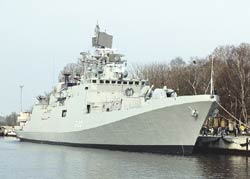|
Kaliningrad: The Yantar Shipyard in Russia's Baltic exclave of Kaliningrad has said it will float out the first of the three Krivak-IV class frigates being built for the Indian Navy at the end of November. The ships are a follow-on order to three Krivak-III class ships earlier constructed by the Baltiysky Zavod shipyard.  Yantar is building three Project 1135.6 modified, Krivak-IV class (also known as the 'Talwar' class) guided missile frigates for the Indian Navy under a $1.6 billion contract signed in July, 2006. Yantar is building three Project 1135.6 modified, Krivak-IV class (also known as the 'Talwar' class) guided missile frigates for the Indian Navy under a $1.6 billion contract signed in July, 2006.
"The first frigate in the series is expected to float out at the end of November," company spokesman Sergei Mikhailov said. "Floating out does not mean that the sea trials will start right away. We still have to carry out post-construction work. The trials will start in 2010," he added. Mikhailov reaffirmed that the shipyard should be able to deliver all three vessels to the customer in 2011-2012. Earlier, in August this year, the Yantar shipyard had confessed that it was negotiating a $60 million loan to enable it to complete construction of the three frigates. According to Igor Orlov, director of Yantar, the shipyard had previously taken out a $110 million loan from Russian national development bank Vnesheconombank (VEB) but was now forced to seek an additional $60 million loan due to "financial constraints." He had also clarified that the Indian government had provided sufficient and timely project financing. The shipyard had then said that it would meet its obligations to deliver the frigates to India by 2012. According to the delivery schedule then announced, the first ship would be floated out this year, the second, in spring 2010, and the third a bit later. It appears that the shipyard has every intention to adhere to the schedule. In modern shipbuilding the 'Float-out' is the process that follows the keel laying and precedes the fitting-out process. It is analogous to the older 'launching' of a ship, a process that has largely been discontinued in modern shipbuilding. The 'floating-out' involves the ship becoming waterborne for the first time. After a ship is ordered for construction, its keel is laid in a dry-dock. After the hull has been substantially completed, the sluice gates are opened and the dry-dock filled with water. The dock gates are then opened and the ship is pulled out by tugboats to a berth where the remaining construction continues. This usually includes further construction of the superstructure, attaching of masts and funnels, and the installation of equipment and furnishings. Russia has previously built three Talwar class frigates for India - INS Talwar (The Sword- the lead ship of the class), INS Trishul (The Trident) and INS Tabar (The Axe). The three ships, being constructed by Yantar, have been designated as INS Teg (The Sabre), INS Tarkash (The Quiver), and INS Trikand (The Bow). The Talwar class frigate has deadweight of 4,000 metric tons and a speed of 30 knots, and is capable of accomplishing a wide range of maritime missions, primarily hunting down and destroying large surface ships and submarines. It is claimed that in terms of firepower the Krivak-IV class frigate will have no rivals in the world in its class. All of the new frigates will be armed with eight BrahMos supersonic cruise missiles rather than 3M-54E Klub-N anti-ship missiles, which were installed on previous frigates. They will be also equipped with a 100-mm gun, a Shtil air defence system, two Kashtan air defence gun/missile systems, two twin 533-mm torpedo tubes, and either a Ka-28 anti-submarine, or a Ka-31 airborne early warning helicopter.
|